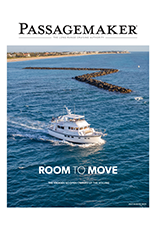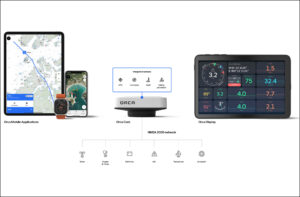
A recent study done by the California Department of Toxic Substances Control concludes that certain non-biocide hull paints are not only better for the environment, but more cost effective for boat owners as well. People in the paint industry, however, say those conclusions overstate the efficacy of “green” paints because their effectiveness also depends on how we use our boats.
The study, funded by the Environmental Protection Agency and performed by the Los Angeles-based Institute for Research and Technical Assistance, began in 2009. It was completed in 2012. The researchers applied 19 non-biocide coating and two copper coatings to fiberglass panels that were then placed in water for a year. They were periodically pulled out of the water and examined. Then, the seven best coatings were placed on 10 boats for a period of two to 10 months, and subsequently examined.
The study also looked into different methods of applying non-biocide paints over previous biocide coatings.
The study concluded that leaving the previous coat of paint on a boat and rolling the new coat on instead of spraying it on can make non-biocide paints cost-effective. Non-biocide paints are made of materials such as silicon with smooth surfaces that are difficult for organisms to attach to. In addition to the cheap application, non-biocide paints also last up to ten years, while biocide ones last about two.
Traditional hull paints contain copper based biocides, which can kill living organisms. The paint is used on vessels large and small to repel marine organisms trying to attach themselves to the hull, thus “fouling” it.
However, anti-fouling paints leak biocides into the water and build up high levels of copper and harm the marine environment. This has become a particular issue for the San Diego Bay, a closed environment with a high concentration of ships.
Non-biocide paints don’t release toxic chemicals but, besides a lack of anti-fouling chemicals, they are also expensive to apply because it involves stripping away the remnants of previous biocide coats before spraying on non-biocide.
Steve Schultz is the president of Luritek, the company that makes Eco-Clad Coating. Eco-Clad creates a biofilm that is like “garlic candy to a barnacle,” Schultz said the inventor described it as. The barnacles don’t the like the taste of the naturally occurring biofilm.
Schultz says that non-biocide paints are effective, but not for all types of boats. Since the non-biocide paints, known as “foul-release” paints, rely on barnacles slipping off a smooth surface, their effectiveness depends on how much the hull moves through the water. Commercial ships, constantly on the move, are ideal for foul-release paints, because it’s difficult for barnacles to settle on the continually moving smooth surface.
But Schultz says pleasure boats are a different story because they often remain stationary for weks and months at a time. In that case, anti-fouling paints are the best bet.
Schultz cites another recent study, this one conducted by the American Coatings Association and its California Paint Council. The study concluded that anti-fouling paints are safe if they have an acceptably restricted release-rate of biocides.
“Maybe the question isn’t copper yes or copper no but copper at a lower release rate that would be allowed in our area,” Schultz said.
The study attributes the overabundance of copper levels in the water to the presence of divers hired to scrub hulls. Many anti-fouling paints, known as hard-bottom paints, create a brittle and rough surface on a hull when the biocides are released. Divers tend to scrape particles of this paint into the water as they are scraping away the barnacles.
In recent years, softer paints, known as ablative, have come into use. These paints naturally wash away over the course of two or three years. However, boat owners still hire divers to scrub the hull of their boat. This releases biocides at a higher rate than they normally would be released.
Because of the nature of ablative paints, Schultz questions the actual cost-effectiveness of rolling on non-biocide paints.
“It still doesn’t overcome the cost or the time factor to have the bottom cleaned on occasion,” he said.
With ablative biocide paints, the bottom of the boat has to be cleaned much less frequently.
If California moves forward to allow lower-release copper paints, Schultz said, boaters would have three options. They could either use the lower-release copper paints, which are more effective for less frequently used vessels (and not employ divers). They could use paints that use alternative biocides, or they could use completely non-biocide paints, proven effective for vessels constantly on the move.
Jim Seidel, the North American Marketing Manager for Interlux and Awlgrip, doesn’t think lower-release copper paint legislation would be a problem for most companies.
“California is looking once again at refuting the amounts of copper, but they’re waiting for some studies to come back so that they can determine the amount of copper that can go into the system and still be absorbed,” Seidel said. “We already have low-release paints available and I imagine most companies, because they know this legislation is there, already have low-release paints.”
For the paint industry’s view on the California legislation, click on this link Cu in CA-CoatingTech.







